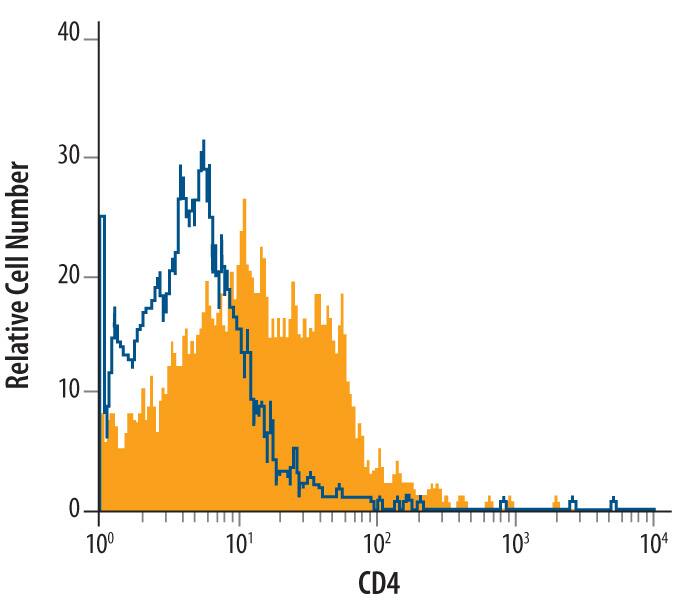Cotton Rat CD4 Antibody
R&D Systems, part of Bio-Techne | Catalog # AF6676

Key Product Details
Species Reactivity
Applications
Label
Antibody Source
Product Specifications
Immunogen
Specificity
Clonality
Host
Isotype
Scientific Data Images for Cotton Rat CD4 Antibody
Detection of CD4 in Cotton Rat Splenocytes by Flow Cytometry.
Cotton rat splenocytes were stained with Sheep Anti-Cotton Rat CD4 Antigen Affinity-purified Polyclonal Antibody (Catalog # AF6676, filled histogram) or isotype control antibody (Catalog # 5-001-A, open histogram), followed by Allophycocyanin-conjugated Anti-Sheep IgG Secondary Antibody (Catalog # F0127).Applications for Cotton Rat CD4 Antibody
CyTOF-ready
Flow Cytometry
Sample: Cotton rat splenocytes
Formulation, Preparation, and Storage
Purification
Reconstitution
Formulation
Shipping
Stability & Storage
- 12 months from date of receipt, -20 to -70 °C as supplied.
- 1 month, 2 to 8 °C under sterile conditions after reconstitution.
- 6 months, -20 to -70 °C under sterile conditions after reconstitution.
Background: CD4
CD4, also known as L3T4, T4, and W3/25, is an approximately 55 kDa type I transmembrane glycoprotein that is expressed predominantly on thymocytes and a subset of mature T lymphocytes. It is a standard phenotype marker for the identification of T cell populations (1). CD4 contains four immunoglobulin-like domains in its extracellular region. Within the ECD, human CD4 shares approximately 52% aa sequence identity with mouse and rat CD4, while mouse and rat CD4 share 73% identity. CD4 is expressed along with CD8 on double positive T cells during their development in the thymus. Either CD4 or CD8 expression is then lost, giving rise to single positive (SP) CD4+ or CD8+ mature T cells (2). CD4+ SP cells, also known as T helper cells, further differentiate into multiple subsets of CD4+ cells including Th1, Th2, Th17, Tfh, and Treg cells which regulate humoral and cellular immunity (3). CD4 is re‑expressed on circulating CD8+ T cells upon activation and contributes to their cytotoxic effector activity (4). In human, CD4 is additionally expressed on macrophages, neutrophils, monocytes, NK cells, and neurons and glial cells in the brain (5 ‑ 8). Similar CD4 distribution between species cannot be assumed as demonstrated by its presence on macrophages in human and rat but not in mouse (5). CD4 binds directly to MHC class II molecules on antigen presenting cells (9). This interaction contributes to the formation of the immunological synapse which is focused around the TCR-MHC class II-antigenic peptide interaction (1, 10). Palmitoylation of two cysteine residues in the cytoplasmic tail of CD4 promotes the localization of CD4 in lipid rafts and its ability to augment TCR signaling via activation of the tyrosine kinase Lck (11). CD4 also functions as a chemotactic receptor for IL-16 and, in human, as a coreceptor for the gp120 surface glycoprotein of HIV-1 (6, 12‑14). CD4 associates with adhesion molecule CD44 at the cell surface, and triggers CD44-mediated cell adhesion (15).
References
- Vignali, D.A.A. (2010) J. Immunol. 184:5933.
- Alarcon, B. and H.M. van Santen (2010) Sci. Signal. 3:pe11.
- Wan, Y.Y. and R.A. Flavell (2009) Mol. Cell Biol. 1:20.
- Kitchen, S.G. et al. (2005) Proc. Natl. Acad. Sci. 102:3794.
- Crocker, P.R. et al. (1987) J. Exp. Med. 166:613.
- Biswas, P. et al. (2003) Blood 101:4452.
- Bernstein, H.B. et al. (2006) J. Immunol. 177:3669.
- Funke, I. et al. (1987) J. Exp. Med. 165:1230.
- Doyle, C. and J.L. Strominger (1987) Nature 330:256.
- Huppa, J.B. et al. (2010) Nature 463:963.
- Fragoso, R. et al. (2003) J. Immunol. 170:913.
- Cruikshank, W.W. et al. (1994) Proc. Natl. Acad. Sci. 91:5109.
- Klatzmann, D. et al. (1984) Nature 312:767.
- Dagleish, A.G. et al. (1984) Nature 312:763.
- Umberto, D. et al. (1999) International Immunology
11(7):1085.
Alternate Names
Entrez Gene IDs
Gene Symbol
Additional CD4 Products
Product Documents for Cotton Rat CD4 Antibody
Product Specific Notices for Cotton Rat CD4 Antibody
For research use only
